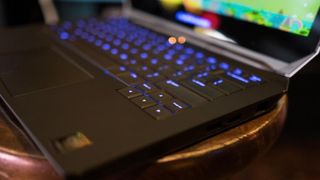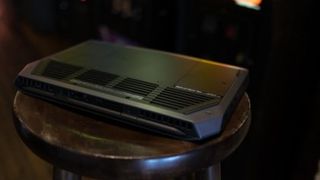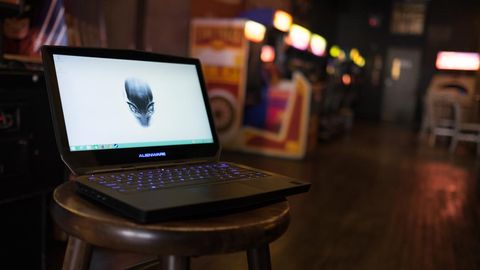Why you can trust TechRadar
Out of the box, the Alienware 13 doesn't create waves with its performance, but it's more than enough to make for a satisfying experience when handling basic tasks, like surfing the web and playing high-resolution video. The Gaming Amplifier helps this laptop reach new heights in terms of gaming performance, but unfortunately, it only gets on by the skin of its teeth without it.
The laptop can play modern titles, like Middle Earth: Shadow of Mordor, at a very playable 44 fps at its lowest settings. Metro: Last Light's benchmark is a sadistic test, and we use it for good reason: to see if gaming hardware can handle some of the most intense graphics available today. It didn't fare as well with this game.
Here's how the Alienware 13 performed with our benchmark tests:
Benchmarks
- 3DMark Cloud Gate: 10,362; Sky Diver: 9,913; Fire Strike: 3,462
- Cinebench CPU: 296 points; Graphics: 83 fps
- PCMark 8 Home: 2,408 points
- PCMark 8 battery life: 3 hours and 14 minutes
- Middle Earth: SoM (Ultra): 13 fps; (Low): 44 fps
- Metro: Last Light (Ultra): 10 fps; (Low): 21 fps
The ability to jack into the optional Graphics Amplifier is an extraordinary feat that, on paper, should be able to visibly enhance gaming performance. But does it? Let's find out.
Benchmarks (with Graphics Amplifier):
- 3DMark Cloud Gate: 10,460; Sky Diver: 13,832; Fire Strike: 7,596
- Cinebench CPU: 297 points; Graphics: 87 fps
- PCMark 8 Home: 2,402 points
- Middle Earth: SoM (Ultra): 55 fps; (Low): 98 fps
- Metro: Last Light (Ultra): 26 fps; (Low): 55 fps
We're getting much better performance here compared to the results sans Graphics Amplifier. But it's easy to see how much of a hamper the dual-core processor (and that 4-pin connector) puts on things. Compared to the MSI GS30 Shadow, which features a quad-core i7-4870HQ, we saw performance gains five-fold over the initial output with its Gaming Dock.

Buying into the most expensive configuration of the Alienware 13 and the Graphics Amplifier, stocked with a GTX 980, will cost roughly $2,400. So, you'd expect to be able to play just about anything on max settings, right? Wrong. Alienware isn't painting too convincing a picture, with or without the Graphics Amplifier.
But if you're just looking to get some light gaming on, especially to catch up on the hits of yesterday, the Alienware 13 is a fine choice. And whatever you're running, the laptop is good at keeping cool.

The fans kick right into gear when gaming gets intense or when I'm running a larger load of programs than usual, but the machine keeps quiet most of the time. It funnels heat toward its rear heat sinks, where the fans are located, so you'll be OK to use this on your lap without frying your own hardware.
Mo pixels, mo problems?
The configuration sent to TechRadar is a modified variation of the $1,399 tier, which Alienware informed us is actually no longer available. However, it features all the same specs found in the current option, which you can check out on Alienware's site if you're curious. However, it comes with one interesting inclusion: a 2,560 x 1,440 touchscreen.
As predicted, this 400-nit IPS panel looks splendid, and the touch implementation works as expected for a Windows 8.1 machine, though it feels unnecessary. The internals can even run the gamut of applications without breaking a sweat. However, if you're looking to game at this screen's native resolution, you'll need to first lower your expectations.
We run all of our gaming benchmarks at 1080p for the sake of consistency, but also because it's the resolution that most of today's gamers want to (or are able to) play on. And despite the inclusion of the QHD screen in the highest tier available of the Alienware 13, its dual-core i7 and GTX 960M can't put up numbers worthy of including it in the first place.

I played some of The Witcher 3: Wild Hunt and recorded my observations. Turning the settings up to ultra on its native resolution, the machine pushed out a consistent 9 fps. Notching things down to the lowest settings on its native, 2,560 x 1,440 resolution outputs a better, but still unplayable 22 fps.
Adjusting the resolution to 1,920 x 1,080 made a sizeable difference. On ultra, the Alienware 13 runs The Witcher 3 at about 14 fps. But on low, it can manage a pretty smooth 30 fps with dips in the lower twenties here and there.
Battery
Things look up for the Alienware 13 when battery life enters the conversation. PCMark 8's battery test predicted that the battery can last up to 3 hours and 14 minutes. But the 52 watt-hour battery exceeded it slightly at three hours and thirty minutes on the balanced power setting, running at 50% brightness and all AlienFX lighting zones off in our anecdotal battery test. This involves stressing the machine with a combination of some relatively lightweight programs, like Spotify, internet chat and Google Chrome, until it runs out of juice.

Against the competition, the Alienware 13 holds up exceptionally well here. The MSI GS30 Shadow powered down after 2 hours and 32 minutes under the weight of a comparable load of tasks. The Aorus X3 Plus v3 was able to provide roughly three hours of battery life. As usual, expect less than pleasing results with the battery inside the Alienware 13 if you're gaming or working with intense applications.
Speaking of apps, the Alienware 13 didn't come stocked with a lot of pre-installed software, thankfully. The few utilities here that did come pre-loaded make using the machine a little easier.
Bundled software
- AlienRespawn: This feature allows you to restore your Alienware machine with one click or back up your data.
- AW Command Center: You can customize the AlienFX lighting zones with this application.
- Alienware Digital Delivery: This app manages digital purchases and prompts you with a free 20GB of cloud storage on DropBox upon booting it up. Not bad!
Cameron is a writer at The Verge, focused on reviews, deals coverage, and news. He wrote for magazines and websites such as The Verge, TechRadar, Practical Photoshop, Polygon, Eater and Al Bawaba.


